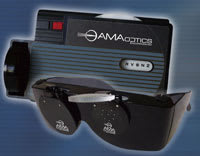spotlight on technology and
technique
AMA
Optics' RAM Provides an Accurate Measure of Retinal Acuity
By Leslie Goldberg, Assistant Editor
The Retinal Acuity Meter (RAM) is the first visual examination device that is clinically proven to accurately measure retinal acuity in eyes with glaucoma, cataract and macular disease and forecast post-operative acuity, says AMA Optics, Miami Beach, Fla.
How to Use the RAM
Clinicians are able to test each patient's eye in less than 1 minute using this handheld, battery-powered device. The RAM technology is a combination of three basic optical principles: small aperture pinhole, correct visual angle and bright illumination. The small aperture pinhole minimizes the effects of refractive errors and media opacities — and near correction is added to maximize resolution. Multiple pinholes allow the patient to select the clearest view through the cloudy media.

"The RAM is a quicker and more convenient instrument than the Guyton Potential Acuity Meter," says Peter Libre, M.D., of Norwalk, Conn. "You can simply pull it out of your coat pocket and it typically takes a minute per eye to run the test."
Functions
The RAM can help determine if unexplained vision loss is due to maculopathy or cataract, and thus prevent costly and time-consuming testing, says AMA Optics. Delays in cataract surgery can be avoided when retinal acuity tests better than anticipated. During an exam, the RAM makes it possible for patients to visualize the letter clarity prior to a procedure and gives them realistic post-surgical expectations.
"If another disease is present, such as epiretinal membrane, AMD or diabetic retinopathy, you may not know pre-operatively how much of the degraded vision is from the cataract and how much is from the retinal abnormality," explains Dr. Libre. "The RAM shows what the potential acuity is. If the potential acuity is normal, then the retina is not part of the problem. If retinal disease is present, vision will not be improved with the RAM test."
"The
RAM often influences my surgical decision-making," says Dr. Libre. "I find it invaluable.
For example, with patients who have cataracts and AMD, the RAM can demonstrate that
the patient may show a large improvement in acuity, so that surgery is worthwhile.
I have sometimes detected an epiretinal membrane in a cataract patient that
I would not have noticed without use of the RAM."
In addition, Dr. Libre uses the RAM in patients with severe glaucoma and cataracts to clarify whether acuity has been degraded by glaucoma.
"Physicians using the RAM to assess the 'functional' capacity of the retina in addition to structural examination signify an emerging trend in eye care," says Tom Minero, director of sales and marketing for AMA Optics. "Many clinical and technological advancements have taken place in this area, and we are eager to introduce the RAM to physicians and their staffs on the front lines of initial examination."
Additional Findings
Prediction of post-operative acuity has been documented prior to cataract removal to within two lines in 92% of eyes, and within one line in 97% of eyes prior to YAG laser capsulotomy when preoperative acuity is better than 20/200. The RAM can also accurately measure potential visual acuity in patients with glaucomatous changes, and in eyes with clear media, can quickly measure acuity without formal refraction.
"Once I started using it, I found the RAM to be indispensable," says Dr. Libre. "I would like to see it more widely used because I think that a lot of people would be saved from unnecessary surgery and many patients who are being told that they should not have surgery yet, could indeed benefit from surgery. The RAM test can help to clarify the appropriate next step for a patient."
For more information on the RAM, contact AMA Optics at (877) 744-3937 or visit the company's Web site at www.amaoptics.com.








